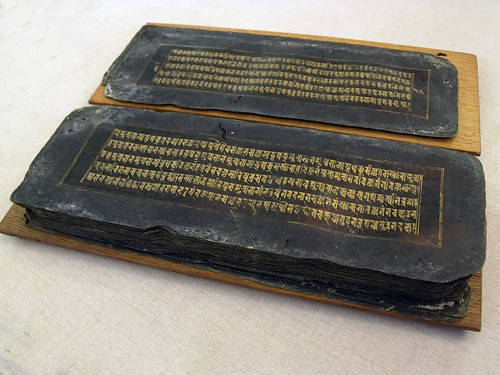Someone recently sent me a picture of a bracelet with a mantra on it, asking if I could translate it. The mantra seemed to transcribe as
ༀ ཨཱཿ ཧཱུྂ གུ རུ བྷྱཿ ཉ༔ ཨ༔ ཤ༔ ས༔ མ༔ ཧ༔ པཪྨ ས མ སེདྡྷེ ཧཱུྂ
oṃ aḥ hūṃ guru bhyaḥ ña a śa sa ma ha parma sa ma siddhi hūṃ
There is a difference between
ཿ and ༔ , the former (
visarga) affects the sound, the latter (
gter tsheg; treasure mark) seems to be decorative. The syllables decorated with the ༔ are a series of
bīja or seed-syllables, some times called a
thödröl (
thos grol)
mantra. The symbol is used with
terma (
gter ma) or revealed teachings. There is a minor error here ཉ༔ should read འ༔ which would transcribe as
'a. So the sequence in the middle is:
'a a śa sa ma ha
This is sometimes written as a ah sha sa ma ha. Some sources say that this mantra requires a special transmission before it can be used. The mantra seems to be associated with passing through the bardos.
The word parma might be a Tibetan word, or more likely a corruption of padma པདྨ. The more I look at it the more it seems that padma was what was intended.
In the word གུ རུ བྷྱཿ (i.e. gurubhyaḥ) the last syllable is badly formed (the top should join up with the vertical stroke on the right), but it must be this. In Sanskrit is the dative plural from of guru, and means 'to or for the gurus'. In Tibetan salutations one sometimes sees
namo gurubhyaḥ namo buddhāya namo dharmāya namo saṅghāya
homage to the teachers, homage to the Buddha, homage to the Dharma,
homage to the Saṅgha
So the mantra, with these minor corrections appears to read:
༄ༀ་ཨཱཿཧཱུྂ་གུ་རུ་ཉ༔ཨ༔ཤ༔ས༔མ༔ཧ༔པཪྨ་ས་མ་སེདྡྷེ་ཧཱུྂ།
oṃ aḥ hūṃ gurubhyaḥ 'a a śa sa ma ha padma sama siddhi hūṃ
With this in mind we start to see references to whose mantra this on the internet. It's the mantra of a self proclaimed Living Buddha, by the name of Lian Sheng, the founder of the True Buddha School. He's apparently popular in East Asia, though not uncontroversial. Lian Sheng seems to be a Chinese form of the name Padmasambhava and the mantra employs elements from the Vajra Guru mantra: oṃ aḥ hūṃ vajra guru padma siddhi hūṃ; plus the bardo mantra: 'a a śa sa ma ha.
Though he is said to be a "Living Buddha" and have 5 million followers I had never heard of him before today. I'd suggest caution in taking him at face value.
48VUPQ3F2G2W




 The University of Cambridge embarked on an exercise of 'linguistic archaeology' late last year, launching a project to survey their extensive collection of India and Nepalese Sanskrit manuscripts. Most of these are Buddhist. Some 2000 birch-bark, and palm-leaf manuscripts were collected in the late 19th and early 20th centuries and not all have been properly catalogued. The manuscripts themselves date from as far back to the 9th century - making them amongst the oldest surviving India manuscripts. Because there has previously been no systematic survey of all the texts it is possible that some treasures may lie waiting to be discovered.
The University of Cambridge embarked on an exercise of 'linguistic archaeology' late last year, launching a project to survey their extensive collection of India and Nepalese Sanskrit manuscripts. Most of these are Buddhist. Some 2000 birch-bark, and palm-leaf manuscripts were collected in the late 19th and early 20th centuries and not all have been properly catalogued. The manuscripts themselves date from as far back to the 9th century - making them amongst the oldest surviving India manuscripts. Because there has previously been no systematic survey of all the texts it is possible that some treasures may lie waiting to be discovered. 
